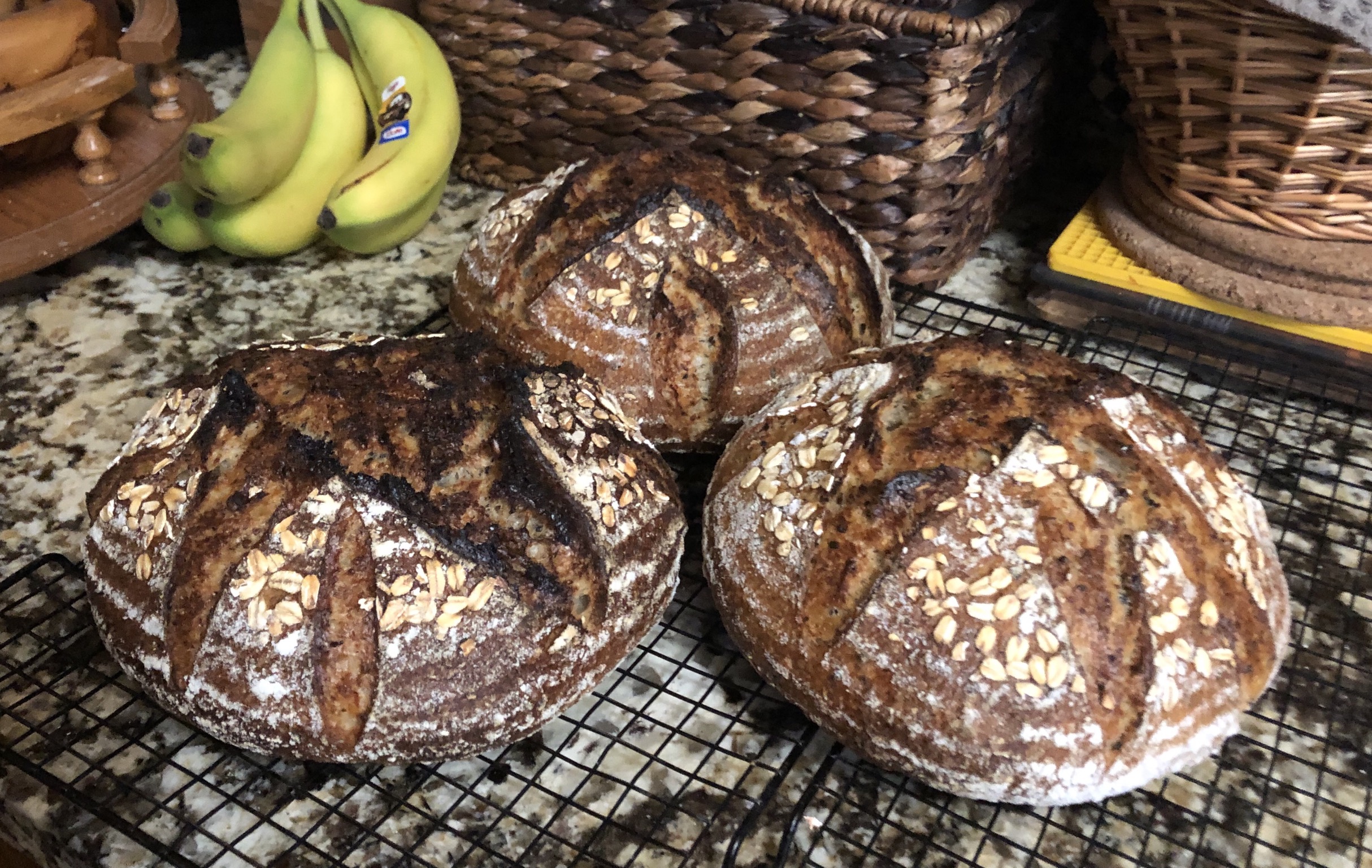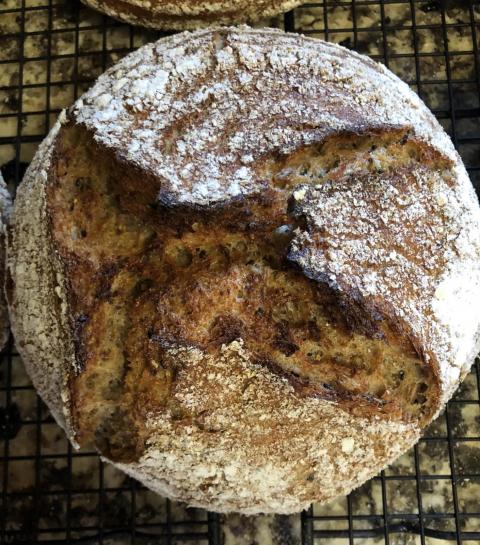This is another one of Cedar Mountain’s recipes. I definitely need more practice handling dough that has this much rye in it. The dough was super extensible but not very elastic. I managed to keep the stickiness down to a minimum by keeping my hands wet during the coil folds, and being liberal and quick during shaping. It felt quite heavy even after bulk even though the bulk was fast compared to my usual bulk times. I gave it at least an hour proof at room temperature before retardation in the hopes of lightening the crumb a bit.
Recipe
Makes 3 loaves
Add-ins
215 g rye berries (to be sprouted and then split into two equal portions)
15 g of black sesame seeds
Dough
300 g freshly milled rye flour (sifted and reserve bran for dusting loaves)
100 g freshly milled red fife flour
50 g freshly milled Kamut flour
550 g strong baker’s unbleached flour
700 g water
30 g yogurt
22 g salt
250 g levain (procedure in recipe)
A few days before:
- Soak the rye berries for the add-ins in filtered water for 8 hours. Drain and rinse every 8 hours until the berries have just started sprouting. I was shocked that they were ready in 24 hours. Then place into fridge until needed.
Two days before:
1. Feed 8 g of your starter 16 g of water and 16 g of unbleached flour. Let that rise at cool room temperature for the day.
Two nights before:
- Feed the levain 40 g of water and 40 of unbleached flour. Let that rise overnight.
The morning before:
1. Feed the levain 100 g of filtered water and 100 g of unbleached flour. Let rise until doubled (about 5 hours).
2. Place into fridge until the next morning.
The night before:
- Mill all the grains necessary for the dough. Sift the bran out of the rye flour and reserve. Place all the flours along with the unbleached flour in a tub and cover. Reserve the barn for dusting the bannetons.
- Divide the sprouted rye berries into two equal amounts. Using a food processor, chop the sprouts until finely ground. Be careful not to turn this into a paste. Add back to the other portion. Refrigerate.
- Toast the black sesame seeds and reserve.
Dough making day:
1. Take the levain and both ground and sprouted rye out of the fridge and place in a warm spot.
2. Mix the water with the flour on the lowest speed in the bowl of a stand mixer until all the flour has been hydrated. Autolyse for at least a couple of hours.
3. After the autolyse, add the salt, the yogurt, and the levain to the bowl. Mix on lowest speed for a minute to integrate everything, then mix on speed 2 for 7 minutes.
6. Add the add-ins to the bowl and continue mixing another 2 minutes or longer until well distributed.
7. Remove dough from bowl and place in a covered tub in a warm spot (oven with light on). Let rest 30 minutes.
8. Do 2 sets of coil folds at 30 minute intervals, then switch to hourly folds for another 2 sets.
9. Let the dough rise about 50%.
10. Tip the dough out on a bare counter, sprinkle the top with flour and divide into portions of ~825 ???g. Round out the portions into rounds with a dough scraper and let rest 30 minutes on the counter.
11. Do a final shape by flouring the rounds and flipping the rounds over on a lightly floured counter. Gently stretch the dough out into a circle. Pull and fold the third of the dough closest to you over the middle. Pull the right side and fold over the middle and do the same to the left. Fold the top end to the center patting out any cavities. Finally stretch the two top corners and fold over each other in the middle. Roll the bottom of the dough away from you until the seam is underneath the dough. Cup your hands around the dough and pull towards you, doing this on all sides of the dough to round it off. Finally spin the dough to make as tight boule.
12. Sprinkle rye bran in the bannetons. Place the dough seam side down in the bannetons, sprinkle more bran on the dough and cover. Let rest for an hour on the counter and then put to bed in a cold (38F) fridge until the next morning.
Baking Day
1. The next morning, heat the oven to 475F with the Dutch ovens inside for an hour. Turn out the dough seam side up onto a cornmeal sprinkled counter. Place rounds of parchment paper in the bottom of the pots, and carefully but quickly place the dough seam side up inside.
2. Cover the pots and bake the loaves at 450 F for 25 minutes, remove the lids, and bake for another 22 minutes at 425 F. Internal temperature should be 205F or more.
These came out flatter than my usual oven spring but I’m happy they aren’t completely flat considering the amount of rye and add-ins in these loaves. Unfortunately these are all claimed for so I won’t know what the crumb is like.














